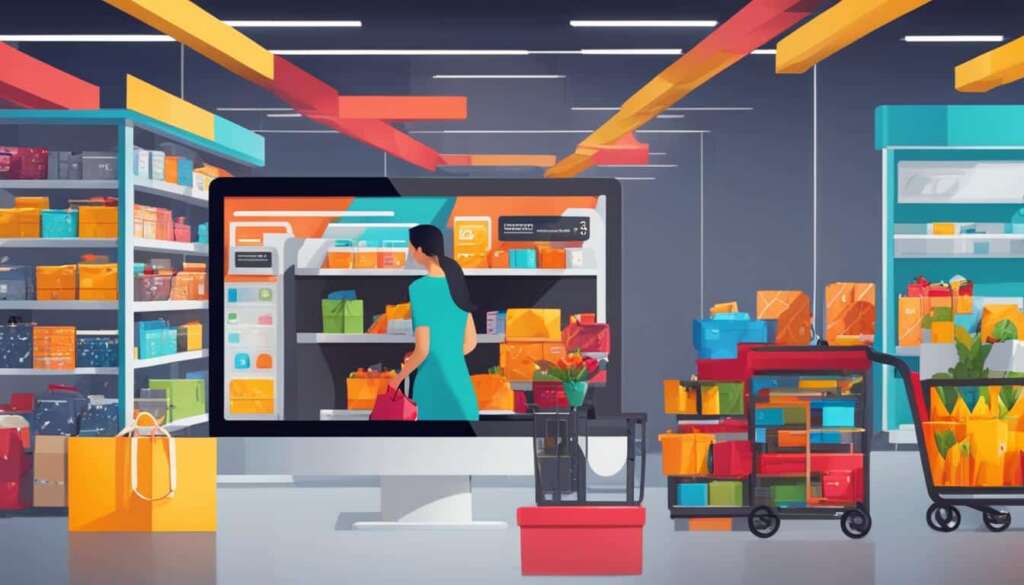Table of Contents
E-commerce has become a popular concept among business owners, with global e-retail sales predicted to reach 7.4 trillion dollars by 2025. Building a dynamic e-commerce application using React can provide a seamless and dynamic retail experience for customers.
Importance of E-Commerce Web Apps Having Dynamic Content
Dynamic content in e-commerce web apps is crucial for creating a seamless and engaging shopping experience. Unlike static pages, dynamic content offers a range of benefits including easier updates, improved user experience, faster loading times, and personalized content tailored to individual user needs.
Updating and modifying content in a dynamic e-commerce app is a breeze. Rather than manually editing each page, dynamic content allows for easy and efficient updates across the entire site. This ensures that the latest products, promotions, and information are always accessible to users, creating a sense of reliability and trust in the brand.
Furthermore, dynamic e-commerce web apps enhance the user experience by providing interactive and personalized content. With dynamic content, you can offer relevant product recommendations, personalized offers, and targeted messaging based on user preferences and browsing behavior. This level of personalization not only increases user engagement but also boosts conversion rates by presenting users with the products and information they are most likely to be interested in.
Another advantage of dynamic content is improved loading times. By utilizing dynamic elements, such as lazy loading and asynchronous scripts, e-commerce web apps can deliver content faster and more efficiently. This is particularly important in today’s fast-paced online environment where users expect instant results and seamless browsing experiences.
“Dynamic content allows for easier updates, improved user experience, faster loading times, and personalized content based on user needs.”
In summary, the importance of dynamic content in e-commerce web apps cannot be overstated. It offers easier updates, improved user experience, faster loading times, and personalized content that enhances customer satisfaction and drives sales. By utilizing dynamic e-commerce web apps, businesses can stay ahead of the competition and provide a seamless online shopping experience for their customers.
Benefits of Dynamic E-Commerce Web Apps
Dynamic e-commerce web apps offer a range of benefits for business owners in the ever-evolving digital landscape. By harnessing the power of dynamic content, these web apps provide improved user experience, faster updates, and personalized content based on user preferences. Let’s explore the advantages in more detail:
- Complete Control over Content: With dynamic e-commerce web apps, you have the freedom to create and modify content without any external dependencies. This control allows you to quickly respond to market trends and provide up-to-date information to your customers.
- Faster Updates: Traditional static pages require manual editing every time an update is needed. Dynamic e-commerce web apps, on the other hand, enable you to make changes seamlessly and efficiently. This means that you can quickly launch new products, update pricing, and modify promotional offers without any downtime.
- Improved User Experience: Dynamic e-commerce web apps focus on enhancing the user experience through interactive and personalized features. By tailoring the content to each user’s preferences, you can offer product recommendations, custom offers, and a more engaging shopping experience.
- Time-Saving Content Management: Managing content becomes a breeze with dynamic e-commerce web apps. You can use content management systems (CMS) to streamline the creation, editing, and publication of content. This results in significant time savings and enables you to concentrate on other aspects of your business.
Case Study: Increased Sales with Dynamic E-Commerce
To further illustrate the benefits of dynamic e-commerce web apps, let’s consider the example of Glam Fashion, an online clothing store. By implementing a dynamic web app, Glam Fashion was able to:
“We saw a 20% increase in sales within the first month of launching our dynamic e-commerce web app. The personalized content and smooth user experience kept our customers engaged and motivated them to make more purchases. The ability to quickly update our inventory and showcase new arrivals has been a game-changer for our business.”
As highlighted by Glam Fashion’s success, dynamic e-commerce web apps have the potential to drive sales and customer satisfaction by offering improved user experience, faster updates, and personalized content.
Stay tuned for the next section where we discuss why React is the perfect choice for building dynamic e-commerce web apps.
Why React is Useful for Dynamic E-Commerce
React, a popular JavaScript library, offers a range of features and benefits that make it highly valuable for building dynamic e-commerce web apps. Whether you’re creating a small online store or a large-scale retail platform, React provides the flexibility and efficiency needed to deliver an outstanding user experience.
One of the key advantages of using React for dynamic e-commerce is the concept of reusable components. By breaking down your application into smaller, modular components, you can save time and effort by reusing code across different parts of your site. This not only speeds up development but also ensures consistency and scalability throughout your e-commerce platform.
Another significant benefit of React is its focus on efficient state management. State refers to the data that determines how a component behaves and appears at any given time. With React’s state management capabilities, you can easily manage and update the state of your e-commerce web app, allowing for real-time updates and a seamless user experience. This is particularly important in an e-commerce context, where product availability, pricing, and other dynamic information can change frequently.
React also offers server-side rendering, which enhances your e-commerce web app’s performance and search engine optimization (SEO) capabilities. By rendering components on the server and delivering them to the client as fully-rendered HTML, React decreases initial load times and improves perceived performance. This is crucial for e-commerce, as fast-loading pages contribute to higher conversion rates and improved customer satisfaction.
Furthermore, React provides easy maintenance and optimization options. The React community has developed numerous tools and libraries that assist in debugging, performance optimization, and testing. This makes it easier to identify and fix issues, optimize code for better performance, and ensure a smooth and efficient operation of your dynamic e-commerce web app.
In summary, React’s reusable components, efficient state management, server-side rendering, and easy maintenance make it a powerful and valuable choice for building dynamic e-commerce web apps. By leveraging React’s capabilities, you can create an engaging and high-performing online shopping experience that meets the evolving needs of your customers.
Why We’re Using a Headless CMS
In the world of e-commerce web development, having a reliable content management system (CMS) is crucial for maintaining and updating your online store. That’s why we have chosen to utilize a headless CMS for our dynamic e-commerce solution.
A headless CMS, such as ButterCMS, offers a range of benefits that make it the ideal choice for content management in an e-commerce setting. Here’s why:
- Easy Content Management: With a headless CMS, managing and organizing your content becomes a breeze. You can easily create, edit, and update product descriptions, blog posts, and other content without any coding knowledge or technical expertise.
- Separation of Content and Presentation: One of the key advantages of a headless CMS is the ability to separate content from its presentation. This means that you can design and implement the front-end of your e-commerce site independently, without being tied to a specific CMS template or theme.
- Compatibility with Any Language or Stack: Unlike traditional CMS platforms that have restrictions on the programming languages or development stacks they support, a headless CMS offers unparalleled flexibility. It can seamlessly integrate with any language or stack, allowing you to leverage your existing technology and infrastructure.
- Scalability: As your e-commerce business grows, so does the need for scalability. A headless CMS can handle high volumes of content and traffic without compromising on performance. This ensures that your online store remains responsive and reliable, even during peak times.
By using a headless CMS, you gain the flexibility and control needed to deliver a seamless shopping experience to your customers. Whether you want to update your product catalog, create engaging blog posts, or tailor content to specific user segments, a headless CMS empowers you to do so with ease.
Exploring the Benefits of Flexibility
The flexibility offered by a headless CMS opens up a world of possibilities for your e-commerce web app. Let’s take a closer look at some of the advantages:
| Advantages | Description |
|---|---|
| Greater Customization | With a headless CMS, you have the freedom to design and customize your online store exactly as you envision it. From unique product pages to personalized checkout experiences, the flexibility of a headless CMS allows you to create tailored solutions for your customers. |
| Improved Performance | By separating content and presentation, a headless CMS reduces the load on your server, resulting in faster loading times for your e-commerce site. This not only improves the user experience but also boosts your search engine rankings, as site speed is a key ranking factor. |
| Easy Integration | Integrating a headless CMS with existing third-party services, such as payment gateways or inventory management systems, is seamless. The flexibility of a headless CMS ensures that you can connect your e-commerce web app with the tools and services that best meet your business needs. |
With a headless CMS and its inherent flexibility, you have the power to create a truly unique and user-friendly e-commerce experience for your customers. The combination of content management, separation of content and presentation, compatibility with any language or stack, scalability, and flexibility makes a headless CMS a valuable asset for your dynamic e-commerce solution.

Tutorial Prerequisites
To follow this tutorial, you will need to have knowledge of React, Redux, ButterCMS, and TailwindCSS. The tutorial will guide you through the process of setting up your development environment and building a dynamic e-commerce app using these technologies.
Before diving into the tutorial, make sure you have a good understanding of the following:
- React: Familiarity with React is essential as it will serve as the foundation for building the dynamic e-commerce app. If you’re new to React, it’s recommended to complete the React documentation and tutorials to gain a solid understanding of the framework.
- Redux: Understanding Redux is crucial for managing the state of your e-commerce app. Make sure you’re comfortable with Redux concepts such as actions, reducers, and store to effectively implement state management.
- ButterCMS: Familiarize yourself with ButterCMS, a headless CMS that will allow you to easily manage and update content for your e-commerce app. Explore the ButterCMS documentation to understand how to integrate it into your project.
- TailwindCSS: Mastery of TailwindCSS will enable you to create beautiful and responsive user interfaces. Ensure that you have a good grasp of the utility-based approach and the various CSS classes provided by TailwindCSS.
By having a strong foundation in React, Redux, ButterCMS, and TailwindCSS, you’ll be well-prepared to follow along with the tutorial and successfully build your dynamic e-commerce app.
Setting Up Your Development Environment
Before delving into the tutorial, it’s crucial to set up your development environment correctly. Ensure you have the following prerequisites installed:
- Node.js: Install the latest version of Node.js, which will provide you with npm (Node Package Manager) to install and manage dependencies for your project.
- Code Editor: Choose a code editor that suits your preference, such as Visual Studio Code, Sublime Text, or Atom. Ensure that your code editor is properly configured for React development.
Once you have the necessary tools in place, you’re ready to embark on your journey to building a dynamic e-commerce app using React, Redux, ButterCMS, and TailwindCSS.
What We’ll Be Building
In this tutorial, we will be building a fully dynamic e-commerce app using React for the user interface, Redux for state management, ButterCMS for content management, and TailwindCSS for styling. We will start by creating the navigation component and the hero section, followed by the products page, single product page, cart functionality, and cart notifications.
“Building a dynamic e-commerce app using React and a headless CMS offers numerous benefits, including improved user experience, faster updates, and personalized content.”
To start our dynamic e-commerce app, we will ensure seamless navigation with the creation of a navigation component. This component will allow users to easily move between different pages and sections of the app.
The hero section, also known as the banner section, plays a crucial role in capturing the attention of users. It is typically positioned at the top of the webpage and used to showcase key products, offers, or promotions. Our hero section will be visually appealing and engaging, drawing users into the e-commerce experience.
Next, we will move on to the products page, where customers can browse and explore a wide range of products. This page will be dynamic, allowing for easy filtering and sorting of products based on various criteria such as price, category, or popularity.
Once users have found a product of interest, they can click on it to view more details on the single product page. This page will provide in-depth information about the product, including images, descriptions, customer reviews, and related products.
Our dynamic e-commerce app will also include cart functionality, allowing users to add products to their cart and proceed to checkout. Users will have the ability to view and update the contents of their cart, apply discounts or promo codes, and select preferred payment and shipping options.
To enhance user experience, we will implement cart notifications. These notifications will provide real-time updates to users, informing them about the status of their cart, such as the addition of new items, changes in availability, or special offers.
Conclusion
Building a dynamic e-commerce app using React and a headless CMS offers numerous benefits for businesses and customers alike. With the power of React, you can create a highly interactive and responsive user interface, providing an enhanced user experience that keeps customers engaged and coming back for more.
One of the key advantages of using React is the ability to easily update and modify your app, ensuring fast and efficient updates. By leveraging the features of a headless CMS, you can seamlessly manage and personalize your content, delivering targeted and relevant information to your customers based on their preferences and behaviors.
The combination of React and a headless CMS provides a powerful foundation for creating a dynamic e-commerce app that adapts to changing market trends and customer demands. With improved user experience, faster updates, and personalized content, you can stay ahead of the competition and drive more sales.
FAQ
What are the benefits of building a dynamic e-commerce app using React?
Building a dynamic e-commerce app using React offers benefits such as reusable components, easy maintenance, efficient state management, and optimization.
Why is dynamic content important in e-commerce web apps?
Dynamic content allows for easier updates, improved user experience, faster loading times, and personalized content based on user needs.
What advantages do dynamic e-commerce web apps offer for business owners?
Dynamic e-commerce web apps provide complete control over content, faster updates, improved user experience, time-saving content management, and personalized content based on user preferences, which can lead to increased sales and customer satisfaction.
What is a headless CMS and why is it useful for e-commerce web apps?
A headless CMS allows for easy content management, separation of content and presentation, compatibility with any language or development stack, and scalability. ButterCMS, a popular headless CMS, offers seamless content management and integration with e-commerce web apps.
What are the prerequisites for following this tutorial?
To follow this tutorial, you will need to have knowledge of React, Redux, ButterCMS, and TailwindCSS. The tutorial will guide you through the process of setting up your development environment and building a dynamic e-commerce app using these technologies.
What will we be building in this tutorial?
In this tutorial, we will be building a fully dynamic e-commerce app using React for the user interface, Redux for state management, ButterCMS for content management, and TailwindCSS for styling. We will cover the creation of the navigation component, hero section, products page, single product page, cart functionality, and cart notifications.
What are the benefits of building a dynamic e-commerce app with React and a headless CMS?
Building a dynamic e-commerce app with React and a headless CMS offers numerous benefits, including improved user experience, faster updates, and personalized content. By following this tutorial, you will be able to create a fully dynamic e-commerce app that leverages the power of React and a headless CMS for seamless retail experiences.







